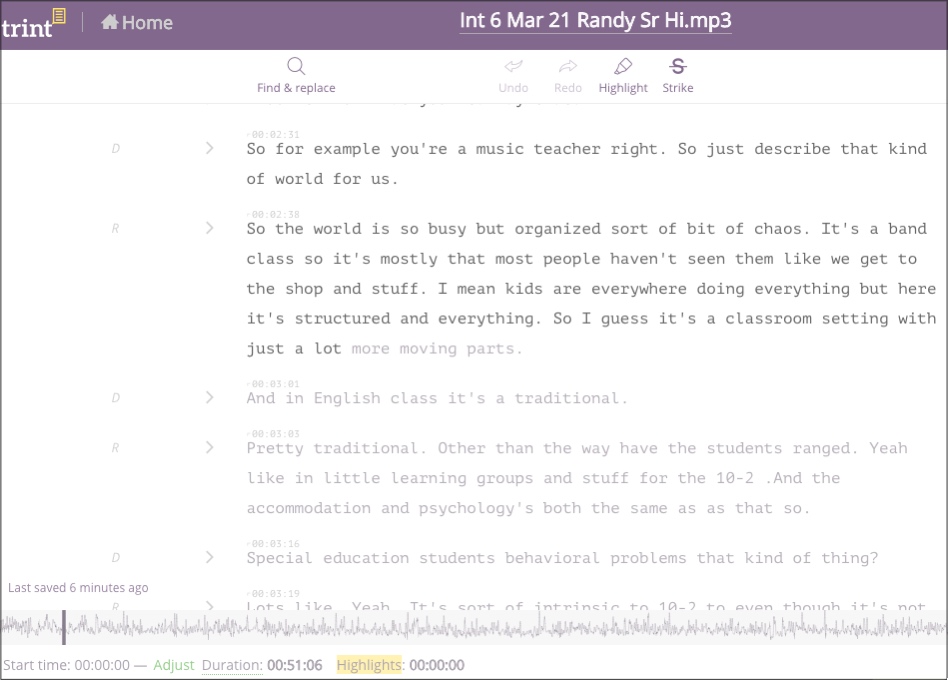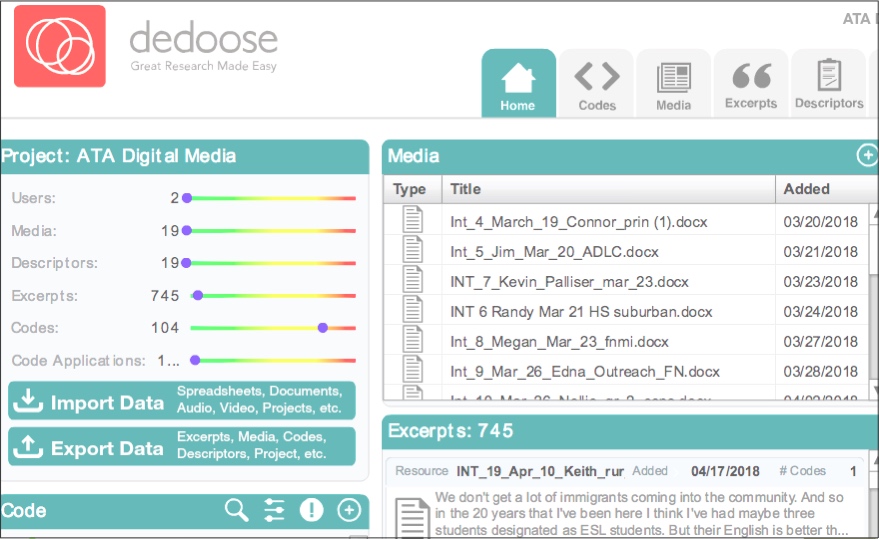For the past two months, I’ve been occupied with a qualitative study of teachers’ use of digital technology in Alberta Schools. The study is sponsored by the Alberta Teachers’ Association. It has been very useful for me to get down to actually doing a full scale qualitative study after years of teaching grad students research methods courses and advising and supervising graduate students.
This post is to highlight (and celebrate) two great tools that we have used that I think have almost revolutionary, or at least potentially disruptive effect on interview based research.
For this study we conducted 19 interviews mostly via Skype or Google Hangout, but also face-to-face and two on the old-fashioned telephone. We recorded the interviews using a variety of digital tools included with Skype or Hangout or recording apps on our machines. We also used a portable digital recorder as backup. The MP3 recordings were then uploaded to new tool – Trint.com
 Trint is an automatic transcription tool, which converts the audio track to text. We uploaded the approx. 50 minute recordings and received notification about 15 minutes later when they had been transcribed to English texts. As expected, the transcription failed (and sometimes comically) at transcribing proper nouns and other slang or colloquial terms relevant only to specialized audiences. The genius of the system is the editor within which the new text transcription is then displayed. This specialized editor has an audio track at the bottom, that reads aloud the audio track. You can vary the audio playback speed that then highlights on the screen the first draft transcription. This editor allowed us to add speaker’s name, insert or delete paragraph breaks, search and replace, delete extraneous chatter and of course has a built-in spell checker. The initial editing took us about the same length of time as the recording runs. So, we went from an Mp3 Audio recording of 50 minutes of clean text in about an hour.
Trint is an automatic transcription tool, which converts the audio track to text. We uploaded the approx. 50 minute recordings and received notification about 15 minutes later when they had been transcribed to English texts. As expected, the transcription failed (and sometimes comically) at transcribing proper nouns and other slang or colloquial terms relevant only to specialized audiences. The genius of the system is the editor within which the new text transcription is then displayed. This specialized editor has an audio track at the bottom, that reads aloud the audio track. You can vary the audio playback speed that then highlights on the screen the first draft transcription. This editor allowed us to add speaker’s name, insert or delete paragraph breaks, search and replace, delete extraneous chatter and of course has a built-in spell checker. The initial editing took us about the same length of time as the recording runs. So, we went from an Mp3 Audio recording of 50 minutes of clean text in about an hour.
We did however notice significant variation in the accuracy of the transcription and thus the length of time needed to manually edit the transcription. The recordings that were done through Skype or Hangout, were very accurate and required minimal editing. Those we recorded on the phone, produced much worse transcription, requiring us to edit and re edit as we listened to the actual interview. Thus, as Trint notes on their home page, the quality of the recording is critical to success.
Trint has an interesting pricing system, that after the first $10 free credit, charges are based upon the length of the transcription submitted. The cost is $15 US per hour, but we were pleasantly surprised that the cost was significantly lower than the actual length of our recordings. So this was money very well spent compared to shipping the transcripts to India or hiring professionals here in Canada. I’ve heard that professional cost for transcription can easy mount to over $300 per hour.
Once we had the text transcript, we uploaded to the cloud-based analysis program Dedoo se. Dedoose.com, is not a new program, but has some interesting features that are certainly an improvement on my earlier work with Atlas and NVivo.
se. Dedoose.com, is not a new program, but has some interesting features that are certainly an improvement on my earlier work with Atlas and NVivo.
First, Dedoose is designed for coding teams. It has extensive tools for training and then testing inter-coder reliability. Next, is the general ease (not too bad a learning curve) of the coding itself. We were quite easily able to code, create new codes, arrange them in families and other functions of high quality qualitative analysis tool set. Finally, Dedoose’s has an integrated suite of quantitive tools. These allow you to look at any significant differences between subjects based on a host of ‘descriptors’ such as gender, school size or whatever variables the research chooses to associate with each of the interviewees. Of course, such quantitative analysis is only meaningful if the coding is done systematically and reliably – a challenge to the very epistemological validity of the subjective experience of qualitative coding. Nonetheless, Dedoose worked as advertised and the coding was straight forward. Retrieval of the code excerpts to a Word file was also quite easy.
Dedoose also has an interesting pricing system. An account is billed (after the free trial) at $14.95 (US)/month – BUT only for the months in which the program is used. I was pleased to see the system remembered my account from over 2 years ago- and I am awaiting to see my monthly charge appear on my credit card.
Now I am looking for a program that writes up the research, recommendations and implications for practice and further research.